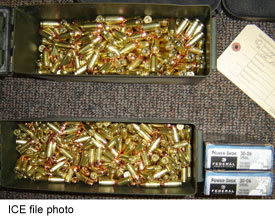
Search
Info Updates
National Threat Advisory
Elevated
![]()
Significant Risk of Terrorist Attacks
Report Suspicious Activity:
1-866-DHS-2-ICE1-866-347-2423
Information for families of ICE detainees:
Contact InformationNews Releases
September 5, 2008
4 men sentenced for illegally exporting thousands of rounds of ammunition
 McALLEN, Texas - Four men were sentenced here Friday to varying terms in federal prison for their roles in illegally exporting hundreds of thousands of rounds of ammunition from the United States into Mexico. The sentences were announced by U.S. Attorney Don DeGabrielle, Southern District of Texas; the case was investigated by U.S Immigration and Customs Enforcement (ICE).
McALLEN, Texas - Four men were sentenced here Friday to varying terms in federal prison for their roles in illegally exporting hundreds of thousands of rounds of ammunition from the United States into Mexico. The sentences were announced by U.S. Attorney Don DeGabrielle, Southern District of Texas; the case was investigated by U.S Immigration and Customs Enforcement (ICE).
Noe Guadalupe Calvillo, 29, Juan Luis Hernandez-Ramos, 37, and Guadalupe Ramiro Munoz-Mendez, 34, are all from Reynosa, Tamaulipas, Mexico; Rogelio Garcia, 47, is from Edinburg, Texas. Calvillo was sentenced to 46 months in federal prison, Garcia to 39 months, Hernandez-Ramos to 37 months, and Munoz-Mendez to 30 months.
The two-count indictment alleged the unlicensed and unauthorized exportation of defense articles from the United States to Mexico. Garcia, Hernandez-Ramos and Munoz-Mendez pleaded guilty to count one, alleging exportation of 30,900 rounds of ammunition. Calvillo pleaded guilty to count two that alleges exportation of 51,400 rounds of ammunition.
ICE agents received information Oct. 2 regarding large amounts of ammunition purchased from several local stores. Garcia was observed during the next two days purchasing large amounts of ammunition from several different stores, and then returning to his home with the ammunition. On Oct. 3, 2007, after making numerous ammunition purchases, Garcia returned to his home where he met with Calvillo and transferred the ammunition to Calvillo's car. The ammunition was then moved to a van driven by Hernandez-Ramos from Calvillo's residence to a location near the U.S.-Mexico border. Hernandez-Ramos met with Munoz-Mendez who then drove his van to the outbound lanes at the U.S. Port of Entry. While that vehicle was being inspected, 21,340 rounds of ammunition were discovered. When Hernandez-Ramos observed Munoz-Mendez's van being searched, he attempted to leave the location. However, ICE agents stopped Hernandez, and a search revealed 9,560 rounds of ammunition. Munoz and Hernandez were taken into custody at that time. Garcia was arrested the following day as he attempted to enter the United States. He later admitted purchasing and transporting about 50,000 or 60,000 rounds of ammunition.
ICE agents were again alerted Oct. 19 to large amounts of ammunition being purchased from local stores. Calvillo was observed meeting with those who purchased the ammunition. A traffic stop was conducted on Calvillo, at which time he admitted his role, and that he had 10,000 rounds of ammunition in his house along with an additional 10,000 rounds of ammunition in the car of yet another person he had asked to purchase ammunition.
Ultimately, Calvillo was held responsible for illegally exporting about 50,000 to 80,000 rounds of ammunition, Garcia for about 50,000 to 60,000 rounds of ammunition, Hernandez-Ramos for about 9,560 rounds of ammunition, and Munoz-Mendez for about 21,340 rounds of ammunition.
The investigation was conducted by ICE and U.S. Customs and Border Protection; Assistant U.S. Attorney Steven T. Schammel, Southern District of Texas, prosecuted this case.
This case was investigated as part of "Armas Cruzadas," an ICE-led bi-lateral program designed to comprehensively identify, disrupt and dismantle trans-border weapons-smuggling networks. The operation aims to stop the illegal export of weapons from the United States and into the hands of drug cartel organizations inside Mexico. Armas Cruzadas will help strengthen interagency cooperation between United States and Mexican federal, state and local law enforcement agencies, and promote the exchange of intelligence through multiple points of contact.
-- ICE --






